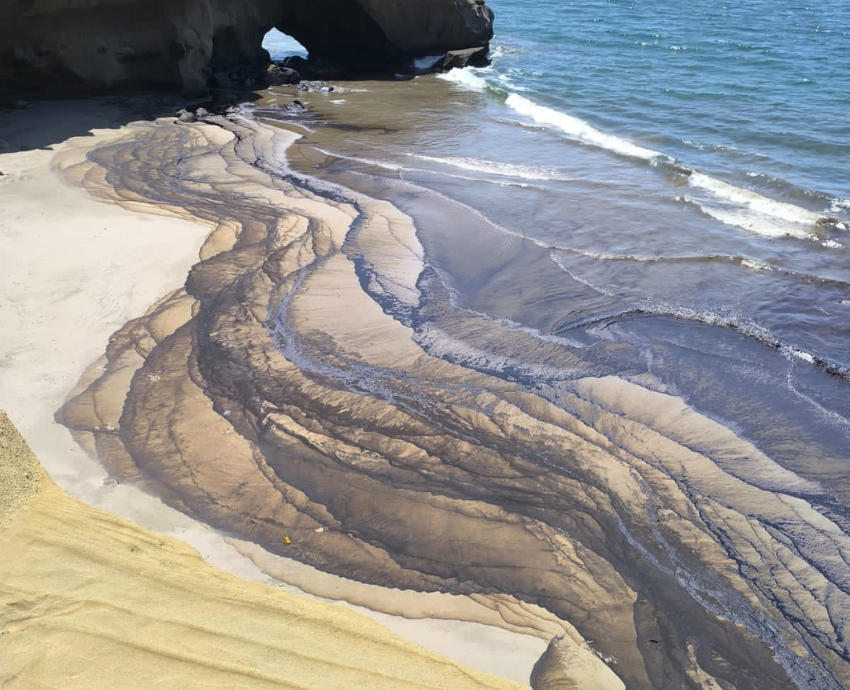
National oil company Petroperú was responsible for a substantial oil spill from its Talara refinery on December 20 in the coastal region of Piura, in Peru’s north. The spill quickly spread northwards along the coast, blanketing the ocean and beaches with crude oil.
The region was reported as a “marine graveyard”, with oil-soaked dolphins, seabirds, fish, turtles, crabs, seahorses and octopuses found washed up dead on beaches.
The country’s environment ministry declared a 90-day “environmental emergency” for the province of Talara, threatening Petroperú with penalties should it not comply with directives to remediate the affected areas.
Óscar Vera, general manager of the Talara refinery — who previously served as energy minister from December 2022 to February 2023 — attempted to minimise the impacts of the oil spill.
“It’s not a spill, it was a small leak,” he said while visiting an affected beach on December 21. He claimed that the affected beaches in Talara province are now “100% clean” and the waters are “crystal clear”.
The local community denounced Vera’s lies, which were clearly exposed by reports of oil-soaked beaches and the continued advance of the spill.
Vera fled a roundtable meeting between fishers, local citizens and authorities in Lobitos on December 27, after locals threw oil at him in protest.
Fishers have been unable to work since the oil spill due to the contamination, affecting an estimated 2500 families.
Local communities have demanded compensation from Petroperú for the impact on fishing and tourism activities and that the company remediate the damage caused by the spill.
Lobitos’ beaches normally attract thousands of local and foreign visitors during the summer months, generating income for local businesses. However, the oil spill has left beaches unusable during the busiest time of the year.
Lobitos council, in the district currently most affected by the oil spill, released a statement on December 25 advising people to not swim or visit beaches in the area.
The oil spill has affected at least seven beaches to date and threatens to continue spreading north to the biodiverse and touristic beaches of Máncora and El Ñuro.
The spill has already reached some parts of the Grau Tropical Marine Reserve, Peru’s most biodiverse marine zone, which contains more than 70% of the country’s marine species.
The latest ecological disaster and the government’s weak, reactive response highlight the largely unregulated functioning of the country’s destructive oil industry.
Oil companies know that they face few consequences for contaminating ecosystems and destroying livelihoods that rely on a clean environment. In the hundreds of reported instances of environmental damage over the past 10 years, Peru’s Agency for Environmental Assessment and Enforcement — attached to the environment ministry — sanctioned companies in just 16% of cases.
Between 1997–2021, 404 oil spills were registered along Peru’s coastline, 88% of which occurred on the north coast in the regions of Piura and Tumbes. A lack of reporting, including oil companies falsifying information about the extent of oil spills or failing to report them at all, means that the extent of pollution is likely much higher.
A spill from Savia’s offshore well in Talara was reported by local fishers on January 25, 2022, after the slick had already spread into the Grau Tropical Marine Reserve. Savia failed to report the spill at all, and only paused operations two days after the spill was first reported.
Ten days earlier, Spanish oil giant Repsol was responsible for spilling nearly 12,000 barrels of oil (1.9 million litres) off Peru’s central coast, which is considered the country’s worst ecological disaster. For days after, Repsol publicly insisted that the amount spilled was only 26 litres, only admitting to the actual extent of the spill more than a month afterwards.
Repsol is now facing a class action lawsuit, on behalf of 30,000 people, for the long-lasting social and ecological impacts caused by the spill.